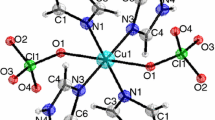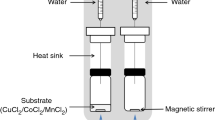Abstract
The paper reports an attempt to correlate the structures of hydrates of copper(II) sulphate with some characteristic features of the kinetics of their thermal decompositions. Non-isothermal thermogravimetric measurements were employed to obtain values of experimental activation energy and entropy for the dehydration of CuSO4 · 5 H2O, CuSO4 · 3 H2O and CuSO4 · H2O. The values ofE * andΔS * for the dehydration of CuSO4 · 3 H2O were found to be only little affected by the mode of preparation of this compound. On the other hand, the values ofE * andΔS * for the dehydration of CuSO4 · ·H2O are strongly dependent on whether this compound was prepared by thermal decomposition of CuSO4 · 5 H2O or CuSO4 · 3 H2O, or by crystallization from solution. As regards the crystalline hydrates of copper(II) sulphate, the greatest energetic hindrance for dehydration was observed for CuSO4 · 3 H2O. The experimental results are also discussed with respect to the present opinions concerning the possibilities of using thermal analyses to obtain information on the relationship between the structures and reactivities of solids.
Résumé
L'article décrit l'étude effectuée dans le but de corréler la structure des hydrates du sulfate de cuivre (II) aux particularités de la cinétique de leur décomposition thermique. A partir de mesures thermogravimétriques non-isothermes, on a obtenu des données expérimentales sur l'énergie d'activation et l'entropie de la déshydratation de CuSO4 · 5H2O, CuSO · 3H2O et CuSO4 · H2O. On a trouvé que les valeurs d'E v etS * de la déshydratation de CuSO4 · 3H2O n'étaient que peu influences par le mode de préparation de ce composé. Par contre, les valeurs d'E * etS * de la déshydratation de CuSO4 · H2O dépendent essentiellement du fait que l'échantillon qui subit la décomposition a été préparé par décomposition thermique de CuSO4 · 5H2O ou CuSO4 · 3H2O, ou bien par cristallisation à partir d'une solution. On discute les résultats expérimentaux en considérant aussi les opinions actuelles sur les possibilités de l'analyse thermique pour obtenir des renseignements sur les relations entre la structure et la réactivité des corps solides.
Zusammenfassung
Der Beitrag berichtet über den Versuch die Struktur der Hydrate von Kupfer(II)sulfat mit einigen charakteristischen Beschaffenheiten der Kinetik ihrer thermischen Zersetzung in Zusammenhang zu bringen. Unter Einsatz nicht-isothermer thermogravimetrischer Messungen wurden die experimentellen Aktivierungsenergie- und Entropiewerte für die Dehydratisierung von CuSO4 · 5H2O, CuSO4 · 3H2O und CuSO4 · H2O erhalten. Es wurde gefunden, daß die Werte der Dehydratisierung von CuSO4 · 3H2O (E * undS *) von der Art der Herstellung dieser Verbindung nur wenig beeinflußt werden. Andererseits sind diese Werte ausdrücklich davon abhängig, ob diese sich zersetzende Verbindung durch thermische Zersetzung von CuSO4 · 5H2O oder CuSO4 · 3H2O, oder durch Kristall aus einer Lösung hergestellt worden war. Von den kristallinen Hydraten des Kupfer(II)sulfat wurde das größte energetische Hindernis der Dehydratisierung bei CuSO4 · 3H2O beobachtet. Die Versuchsergebnisse werden auch hinsichtlich der gegenwärtigen Meinungen betreffs Möglichkeiten der thermischen Analysen zum Erhalt von Informationen über die Zusammenhänge zwischen Struktur und Reaktivität von Festkörpern erörtert.
Резюме
В статье приведены по пытки корреляции структуры гидратов с ульфата меди(П) с некоторыми характе рными особенностями кинетики их термического разлож ения. Используя для этой цели неизоте рмические термогравиметричес кие измерения, были по лучены экспериментальные э нергия активации и эн тропия дегидратации CuSO4 · 5H2O, CuSO4 · · 3H2O и CuSO4 · H2O. Найдено, что з наченияE * иΔS * дегидратации CuSO4 · 3H2O в оч ень малой степени завися т от способа получени я этого соединения. Однако, зн аченияE * иΔS * процесса дегидрат ации CuSO4 · H2O явно зависят от того что это соединен ие получено термическим разложе нием CuSO4 · 5H2O или CuSO4 · 3H2O или же кристаллизацией и з раствора. Среди иссле дованных кристаллог идратов сульфата меди(П) наибо лее энергетическое препятствие дегидра тации отмечено для CuSO4 · 3H2O. Экспериментальные р езультаты обсуждены в отношени и существующих мнени й, касающихся возможно стей термического анализа в получении и нформации о взаимосв язи между структурой и реакцио нной способностью тверды х веществ.
Similar content being viewed by others
References
A. V. Nikolaev andV. A. Logvinenko, J. Thermal Anal., 13 (1978) 253.
H. Langfelderová, J. Thermal Anal., 12 (1977) 413.
J. Simon, J. Thermal Anal., 4 (1972) 205.
E. V. Margulis andG. I. Čufarov, Zh. Fiz. Khim., 45 (1971) 1261.
V. A. Logvinenko, O. V. Gegola andL. I. Myachina, J. Thermal Anal., 14 (1979) 265.
H.Langfelderová, M.Linkešová, M.Serator and J.Gažo, J. Thermal Anal., in press.
A. V. Coats andJ. P. Redfern, Nature, 201 (1964) 68.
J. Zsakó, Phys. Chem., 72 (1968) 2406.
D. Young, Decomposition of Solids, (in Russian), MIR, Moskow, 1969.
N. Z. Liachov andV. V. Boldyrev, Uspk. Khim., 41 (1972) 1960.
J. Cooper, J. Calvin andJ. Hume, Trans. Faraday Soc., 29 (1933) 576.
H. G. Wiedemann, E. Sturzenegger andG. Bayer, Thermal Analysis, Proc. IVth ICTA, Vol. 1, p. 227, Budapest, 1974.
R. F. Zahrobsky andW. H. Baur, Acta Cryst., 24B (1968) 508.
G. E. Bacon andN. A. Curry, Proc. Royal Soc., A 266 (1962) 95.
S. Saaring, Thermochim. Acta, 7 (1973) 297.
L. Ben-Dor andR. Margalith, Inorg. Chim. Acta, 1 (1967) 49.
G. Liptay, E. Papp-Molnár andK. Burger, J. Inorg. Nucl. Chem., 31 (1969) 247.
A. V. Nikolaev, V. A. Logvinenko, V. M. Gorbatchov andL. I. Myachina, Thermal Analysis, Proc. IVth ICTA, Vol 1, p. 95, Budapest, 1975.
Author information
Authors and Affiliations
Rights and permissions
About this article
Cite this article
Langfelderovà, H., Linkešová, M. & Jóna, E. The relationship between the structures of Cu(II) complexes and their chemical transformations. Journal of Thermal Analysis 19, 117–123 (1980). https://doi.org/10.1007/BF01928437
Received:
Issue Date:
DOI: https://doi.org/10.1007/BF01928437




